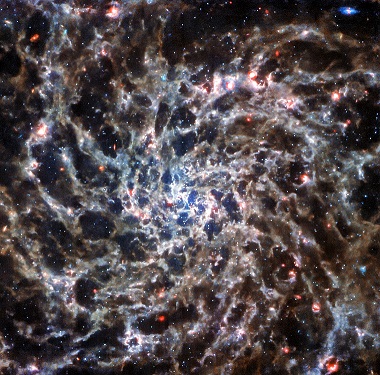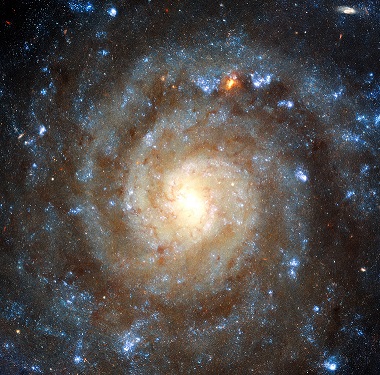Exposing Galactic Bones
Spiral galaxy IC-5332 (credit: NASA/JWST)
The Webb space telescope has photographed the spiral galaxy IC-5332 anew. According to NASA, the Webb's infrared (IR) image is unprecedented in its details revealing the bones of a galaxy. IC-5332 lies more than 29 million light-years from Earth, has a diameter of 66 000 light-years across, and is smaller than our Milky Way. The galaxy is almost perfectly face-on with respect to Earth so the observatory views the complete symmetrical sweep of its arms, ie. "bones".
The new telescope carries multiple cameras that can peer into the universe using several IR wavelengths that can see different structural details. The Webb image was captured in the mid-infrared region of the light spectrum. It required the camera operate in an environment only a few degrees above absolute zero for the IR sensors to properly function.


Spiral galaxy "bones" (credit NASA/Webb telescope) Spiral galaxy dust (credit: NASA/Hubble telescope)
A comparison image pf the IC-5332 was previous taken by cameras on the Hubble telescope but its cameras are not cold enough for infrared imaging. The JWST photo is shown beside the Hubble image shown in ultraviolet and visible light and the differences are obvious. The Hubble image shows dark regions that appear to separate the galaxy's spiral arms, while the Webb photograph shows a tangle of structures that echo the spiral arms’ shape. The difference is due to dusty galactic regions seen by Hubble. Ultraviolet and visible light are scattered by dust than if seen in IR light. The dust is no longer seen in the Webb image as mid-infrared light passes directly through it.
However you view the separate photographs they are stunning examples of visual, engineering, and scientific accomplishments. WHB